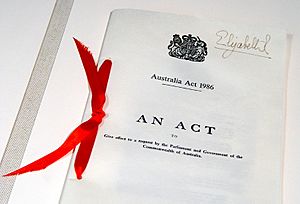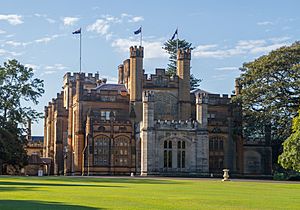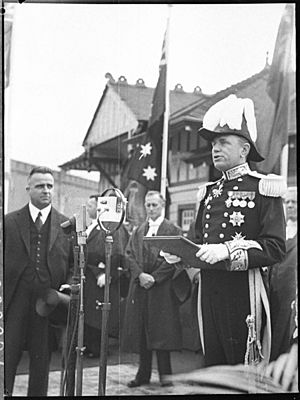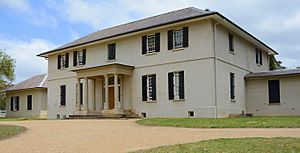Governor of New South Wales facts for kids
Quick facts for kids Governor of New South Wales |
|
|---|---|

Standard of the Governor
|
|
| Viceregal | |
| Style | Her Excellency the Honourable |
| Residence | Government House, Sydney |
| Seat | Sydney |
| Appointer | Monarch
on the advice of the premier
|
| Term length | At His Majesty's pleasure
(usually 5 years by convention)
|
| Formation | 7 February 1788 |
| First holder | Arthur Phillip |
| Deputy | Lieutenant-Governor of New South Wales |
| Salary | $529,000 |
The Governor of New South Wales is a very important person in the state of New South Wales, Australia. They represent the King, Charles III, who is Australia's monarch. Think of the Governor as the King's personal representative in New South Wales.
Just like the Governor-General does for all of Australia, the Governor of New South Wales handles important duties for the state. These duties include both official government tasks and special public events. The King chooses the Governor based on advice from the Premier of New South Wales, who is the leader of the state government. A Governor usually serves for about five years, but their term can be longer or shorter. The current Governor is retired judge Margaret Beazley, who started her role on May 2, 2019.
The role of Governor started way back in 1788 when New South Wales was first settled by the British. It's the oldest continuous official position in Australia! At first, the Governor represented the British government. But over time, especially after laws like the Australia Act 1986 were passed, the Governor became the direct representative of the Australian monarch. This means they act for the King of Australia, not the British government.
Contents
How the Governor is Chosen
The rules for choosing the Governor are set out in the New South Wales Constitution. The King appoints the Governor after the Premier of New South Wales suggests who it should be. This appointment is made official with special documents signed by the King.
Before starting the job, the new Governor takes two important promises: the Oath of Allegiance (to be loyal to the King) and the Oath of Office (to do their job well). These promises are usually made in front of the Chief Justice, who is the top judge in New South Wales. The King also meets the new Governor and gives them a special award called the Companion of the Order of Australia (AC).
Governors usually serve for at least five years. However, they technically serve "At His Majesty's pleasure", meaning the King can decide their term length. The Premier can ask the King for the Governor to stay longer, sometimes more than seven years. A Governor can also resign, and a few have passed away while in office.
If the Governor is away from New South Wales for more than a month, or if they can't do their job, the Lieutenant-Governor of New South Wales steps in. Since 1872, the Chief Justice of New South Wales has also held the role of Lieutenant-Governor. If both the Governor and Lieutenant-Governor are unavailable, the next most senior judge of the Supreme Court takes over.
Who Can Be Governor?
For a long time, from 1788 to 1957, all Governors were born outside New South Wales, usually in Britain. Many were even members of the British nobility. However, things changed, and Australians started to fill the role. Sir John Northcott, appointed in 1946, was the first Australian-born Governor of any state. But he was born in Victoria. The first Governor born in New South Wales was Sir Eric Woodward, appointed in 1957. This continued until 1996, when Gordon Samuels, who was born in London but moved to Australia, became Governor.
Early Governors were often former politicians or military officers. In fact, most Governors have had a military background. However, they must remain neutral in politics while in office. Gordon Samuels was the first Governor without a political or public service background; he was a former judge. The first woman to hold this important position was Dame Marie Bashir, who was also the first Governor of Lebanese-Australian heritage.
What the Governor Does
Since the King lives outside New South Wales, the Governor's main job is to carry out the King's duties for the state.
The Governor has the power to appoint the ministers who run the Government of New South Wales. By tradition, the Governor must choose the leader of the Legislative Assembly (the state parliament) who has the support of most members to be the Premier. The Premier then advises the Governor on who should be appointed as other ministers.
The government makes decisions through the "Governor-in-Council." This means the Governor acts with the advice of the Executive Council of New South Wales, which is made up of cabinet ministers. This process makes government decisions official and legal. Usually, the Governor must follow the advice of the ministers. However, in very rare and special situations, the Governor can act without or against their advice. These are called "reserve powers." For example, in 1932, the Governor used these powers to remove Premier Jack Lang from office due to serious concerns about his actions.
The Governor is also the only one who can officially call a meeting of the Parliament. They can also end a parliamentary session or dissolve Parliament, usually on the Premier's advice. When a new law is passed by Parliament, the Governor gives it "Royal Assent" in the King's name. This is the final step to make a bill into a law. In the past, Governors could refuse to approve bills, but now they almost always approve them, unless there's a serious legal problem with how the bill was passed.
While the Governor has important constitutional roles, much of their work today is ceremonial. They host members of Australia's Royal Family, as well as leaders and royalty from other countries. They also receive official documents from foreign Consuls-general who work in Sydney. When the Governor of New South Wales has served the longest among all state Governors, they can also act as the Administrator of the Commonwealth if the Governor-General of Australia is out of the country. Margaret Beazley currently holds this role.
The Governor also helps promote unity and pride in the state. They present national medals and awards to people, though the very highest awards are given by the Governor-General. The Governor also holds honorary military titles, such as Honorary Colonel of the Royal New South Wales Regiment, and is the Chief Scout for New South Wales.
Symbols and Traditions
The Governor is a very important figure in New South Wales. They are second in official importance only to the Governor-General. While in office, the Governor is called His Excellency or Her Excellency. Since 2013, Governors and former Governors of New South Wales are also allowed to use the title "The Honourable".
When they start their role, the Governor is usually given a special award from the Most Venerable Order of the Hospital of Saint John of Jerusalem. They are also usually made a Companion of the Order of Australia. In the past, Governors wore fancy uniforms with tailcoats and plumed hats, but this tradition stopped in 1946 with the first Australian-born Governor, Sir John Northcott.
When the Governor arrives at a formal event where there's a military guard, a special piece of music called the "vice regal salute" is played. This music is made up of the first and last parts of Australia's national anthem, "Advance Australia Fair".
To show that the Governor is present at a building, on a ship, plane, or in a car, a special flag called the Governor's standard is used. New South Wales adopted its own unique Governor's standard in 1981. Before that, the Union Flag (the flag of the United Kingdom) was used. The new flag is the New South Wales State Flag with a crown above the state badge.
- Past and present standards of the governor
History of the Governor's Role
The role of Governor of New South Wales is the oldest official position in Australia, even older than the country itself! Captain Arthur Phillip became the first Governor on February 7, 1788, when the British colony of New South Wales was officially started. In the early days, Governors had a lot of power because they were so far from Britain. But in 1824, the New South Wales Legislative Council was created to advise the Governor, which was Australia's first law-making body.
Between 1850 and 1861, the Governor of New South Wales was even called "Governor-General" as an early idea to unite the Australian colonies. All communication between the colonies and Britain was supposed to go through this Governor-General. But as other colonies gained more self-government, they got their own Governors.
When the six British colonies in Australia joined together to form the Commonwealth of Australia in 1901, New South Wales became a state. The New South Wales Constitution Act 1902 then set up the modern system of government for the state. In the early years after Australia became a nation, the Governor of New South Wales still acted as a link between the state government and the British government in London.

Over time, Australia became more independent. In 1942, Australia passed a law that made it a "dominion" under the Statute of Westminster. This meant that even though Australia and Britain shared the same monarch, the monarch acted differently for each country. For Australian matters, the monarch would act on the advice of Australian ministers, not British ones. However, this didn't change the situation for the Australian states right away. The Governor of New South Wales still formally represented the British monarch.
This seemed a bit odd, given Australia's growing independence. So, after many discussions between the Australian and British governments, the Australia Act 1986 was passed. This important law removed any remaining constitutional ties between the Australian states and the British government. It made it clear that the Governor of New South Wales (and other state Governors) is the direct, personal representative of the Australian monarch, not the British monarch or government, and not the Governor-General or the Australian federal government.
Where the Governor Lives
Government House

When Governor Phillip first arrived in Sydney in 1788, he lived in a simple house. Later, a more permanent building was built, known as First Government House. This house was used by Governors until 1845, when they moved to a grand new building called Government House, Sydney.
When Australia became a federation in 1901, Government House in Sydney was used as a second home for the new Governor-General of Australia. Because of this, the New South Wales Governor moved to a different residence called Cranbrook. This arrangement lasted until 1913, when the Governor-General moved to Admiralty House, and the New South Wales Governor returned to Government House.
In 1996, Premier Bob Carr announced that the new Governor, Gordon Samuels, would not live or work at Government House. Carr said he wanted the Governor's office to be "less associated with pomp and ceremony." However, in October 2011, Premier Barry O'Farrell announced that the Governor, Dame Marie Bashir, would move back into Government House. He believed it was important for the Governor to live there, as it was built for that purpose. Since December 2013, the Governor's office has managed the residence again.
Summer Home
Besides their main home in Sydney, many early Governors also felt they needed a "summer retreat" to escape the hot Sydney summers. In 1790, Governor Phillip had a second home built in Parramatta. Later, a more permanent building, Old Government House, was built on the same spot. This home was used until the main Government House in Sydney was finished in 1845.
Even after that, Governors still wanted a country home for summer. From 1885 to 1957, a property called "Hillview" in Sutton Forest was used as the official summer residence. However, in 1957, Hillview was sold because it was seen as unnecessary and expensive. In 1985, Hillview was returned to the people of New South Wales and is now managed by the Department of Planning & Environment.
Governor's Staff
The Governor has a team of staff who help them with their official duties. This team is called the Office of the Governor. It includes people like assistants, press officers, financial managers, speech writers, and event planners. There are also chefs, waiters, cleaning staff, and tour guides. All these people and departments are often referred to as Government House. Their work is paid for through the annual budget, which also covers the Governor's salary of $529,000.
List of Governors of New South Wales
The following individuals have served as a Governor of New South Wales:
| No. | Portrait | Governor | Term start | Term end | Time in office | |||
|---|---|---|---|---|---|---|---|---|
| Governors appointed by George III (1760–1820): | ||||||||
| 1 |  |
Captain Arthur Phillip , RN | 7 February 1788 | 10 December 1792 | 4 years, 307 days | |||
| 2 |  |
Captain John Hunter RN | 11 September 1795 | 27 September 1800 | 5 years, 16 days | |||
| 3 |  |
Captain Philip Gidley King RN | 28 September 1800 | 12 August 1806 | 5 years, 318 days | |||
| 4 |  |
Captain William Bligh FRS, RN | 13 August 1806 | 26 January 1808 | 1 year, 166 days | |||
| 5 |  |
Major-General Lachlan Macquarie CB | 1 January 1810 | 1 December 1821 | 11 years, 334 days | |||
| Governors appointed by George IV (1820–1830): | ||||||||
| 6 |  |
Major-General Sir Thomas Brisbane Bt, GCH, GCB | 1 December 1821 | 1 December 1825 | 4 years, 0 days | |||
| 7 |  |
Lieutenant General Sir Ralph Darling GCH | 19 December 1825 | 21 October 1831 | 5 years, 306 days | |||
| Governors appointed by William IV (1830–1837): | ||||||||
| 8 |  |
Major-General Sir Richard Bourke KCB | 3 December 1831 | 5 December 1837 | 6 years, 2 days | |||
| Governors appointed by Queen Victoria (1837–1901): | ||||||||
| 9 |  |
Major Sir George Gipps | 24 February 1838 | 11 July 1846 | 8 years, 137 days | |||
| 10 |  |
Lieutenant Colonel Sir Charles Augustus FitzRoy KCH, KCB | 3 August 1846 | 28 January 1855 | 8 years, 178 days | |||
| 11 |  |
Sir William Denison KCB | 20 January 1855 | 22 January 1861 | 6 years, 2 days | |||
| 12 |  |
The Rt Hon. Sir John Young Bt, GCMG, KCB | 16 May 1861 | 24 December 1867 | 6 years, 222 days | |||
| 13 |  |
The Rt Hon. The Earl Belmore GCMG, PC | 8 January 1868 | 21 February 1872 | 4 years, 44 days | |||
| 14 |  |
The Rt Hon. Sir Hercules Robinson GCMG | 3 June 1872 | 19 March 1879 | 6 years, 289 days | |||
| 15 |  |
The Rt Hon. Lord Augustus Loftus GCB | 4 August 1879 | 9 November 1885 | 6 years, 97 days | |||
| 16 |  |
The Rt Hon. The Lord Carrington GCMG, PC | 12 December 1885 | 3 November 1890 | 4 years, 326 days | |||
| 17 |  |
The Rt Hon. The Earl of Jersey GCB, GCMG, PC | 15 January 1891 | 2 March 1893 | 2 years, 46 days | |||
| 18 |  |
The Rt Hon. Sir Robert Duff GCMG | 29 May 1893 | 15 March 1895 | 2 years, 291 days | |||
| 19 |  |
The Rt Hon. The Viscount Hampden GCMG | 21 November 1895 | 5 March 1899 | 3 years, 104 days | |||
| 20 |  |
The Rt Hon. The Earl Beauchamp KCMG, PC | 18 May 1899 | 30 April 1901 | 1 year, 347 days | |||
| Governors appointed by Edward VII (1901–1910): | ||||||||
| 21 |  |
Admiral Sir Harry Rawson GCB, GCMG, RN | 27 May 1902 | 27 May 1909 | 7 years, 0 days | |||
| 22 |  |
The Rt Hon. The Lord Chelmsford GCMG | 28 May 1909 | 11 March 1913 | 3 years, 287 days | |||
| Governors appointed by George V (1910–1936): | ||||||||
| 23 |  |
The Hon. Sir Gerald Strickland GCMG | 14 March 1913 | 27 October 1917 | 4 years, 227 days | |||
| 24 |  |
Sir Walter Davidson KCMG | 18 February 1918 | 4 September 1923 | 5 years, 198 days | |||
| 25 |  |
Admiral Sir Dudley de Chair KCB, MVO | 28 February 1924 | 7 April 1930 | 6 years, 38 days | |||
| 26 |  |
Air Vice Marshal Sir Philip Game GBE, KCB, DSO | 29 May 1930 | 15 January 1935 | 4 years, 231 days | |||
| 27 |  |
The Rt. Hon. The Lord Gowrie VC, GCMG, CB, DSO | 21 February 1935 | 22 January 1936 | 335 days | |||
| Governors appointed by Edward VIII (1936): | ||||||||
| 28 |  |
Admiral Sir Murray Anderson KCB, KCMG, MVO | 6 August 1936 | 30 October 1936 | 85 days | |||
| Governors appointed by George VI (1936–1952): | ||||||||
| 29 |  |
The Rt. Hon. The Lord Wakehurst KCMG | 8 April 1937 | 8 January 1946 | 8 years, 275 days | |||
| 30 |  |
Lieutenant General Sir John Northcott KCMG, KCVO, CB | 1 August 1946 | 31 July 1957 | 10 years, 364 days | |||
| Governors appointed by Queen Elizabeth II (1952–2022): | ||||||||
| 31 |  |
Lieutenant General Sir Eric Woodward KCMG, KCVO, CB, CBE, DSO | 1 August 1957 | 31 July 1965 | 7 years, 364 days | |||
| 32 |  |
Sir Roden Cutler VC, KCMG, KCVO, CBE | 20 January 1966 | 19 January 1981 | 14 years, 365 days | |||
| 33 |  |
Air Marshal Sir James Rowland AC, KBE, DFC, AFC | 20 January 1981 | 20 January 1989 | 8 years, 0 days | |||
| 34 |  |
Rear Admiral Sir David Martin KCMG, AO, RAN | 20 January 1989 | 7 August 1990 | 1 year, 199 days | |||
| 35 | Rear Admiral The Hon. Peter Sinclair AC | 8 August 1990 | 29 February 1996 | 5 years, 205 days | ||||
| 36 |  |
The Hon. Gordon Samuels AC, CVO, QC | 1 March 1996 | 28 February 2001 | 4 years, 364 days | |||
| 37 |  |
Professor The Hon. Dame Marie Bashir AD, CVO | 1 March 2001 | 1 October 2014 | 13 years, 214 days | |||
| 38 |  |
General The Hon. David Hurley AC, DSC (Retd) | 2 October 2014 | 1 May 2019 | 4 years, 211 days | |||
| 39 |  |
The Hon. Margaret Beazley AC, KC | 2 May 2019 | Incumbent | 6 years, 236 days | |||
See also
 In Spanish: Gobernador de Nueva Gales del Sur para niños
In Spanish: Gobernador de Nueva Gales del Sur para niños
- Spouse of the governor of New South Wales
- Governor-General of Australia
- Governors of the Australian states
- Governor's Body Guard of Light Horse







